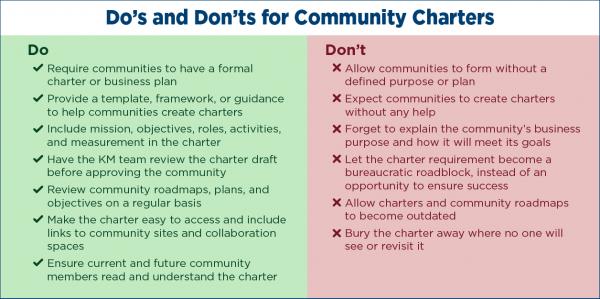
A community charter outlines the purpose, objectives, and scope of a community of practice. It also articulates operational aspects such as who will manage the community, what resources it will need, and how success will be measured.
Many organizations claim to have communities of practice because they’ve created topic-based intranet sites or discussion groups and encouraged employees to “go collaborate.” These informal communities tend to flame out quickly—assuming they ever get off the ground. Members don’t know what they’re supposed to share or why they should even bother.
To be sustainable, a community needs a driving purpose, a plan of action, and a “hook” to get members in the door. A charter is a great way to create consensus around these details and ensure community sponsors and leaders are asking the right questions. The value of charters is clear in our research: 91% of community programs that require charters are rated as effective by KM managers and stakeholders, compared to 27% that do not.
What Successful Community Charters Look Like
Every organization can decide how to format its community charters and exactly what they should contain. However, APQC recommends including certain standard categories:
- Community purpose statement—a high-level overview of why the organization has created the community and the value it provides to members and the business.
- Key roles—someone willing to lead the community, an executive sponsor willing to secure resources and troubleshoot issues, and any other necessary personnel.
- Community objectives—what the community plans to achieve. Objectives work best when they are tangible, such as “our community will document X business process” or “will train up-and-coming members on Y.” Objectives may change annually or be more evergreen.
- Community scope—what the community will and will not do. For example, the community might document, validate, and recommend best practices, but not implement them (since that’s the responsibility of the relevant process owners).
- Business goals and objectives—how community objectives support business needs. For example, the community might support a broader digital transformation effort, or it might aim to improve specific cycle time or quality KPIs.
- Resources—what needs to be in place for the community to succeed. This might include time for employees to lead and participate, budget for community activities or initiatives, and supporting technology.
- Metrics—how community success will be evaluated. A balanced portfolio of measures includes activity metrics (e.g., webinars hosted, best practices documented) as well as business metrics the community aims to influence.
- Critical success factors and barriers—what needs to happen to ensure community success, and what challenges might the community need to overcome to meet its goals.
Designing and Using Community Charters
Most organizations provide a template to ensure standard charters across communities. Charters do not need to be overcomplicated—one or two pages are usually sufficient. However, they should be revisited and updated annually or in response to market or organizational changes that may affect the community mission.
Develop Your Own Community Charter
APQC’s Community of Practice Charter Template is a good jumping-off place to create a community charter. You can also review examples of real charters from ENGIE and Schneider Electric in The Do's and Don'ts of Community Charters. More information about communities of practice can be found in:
